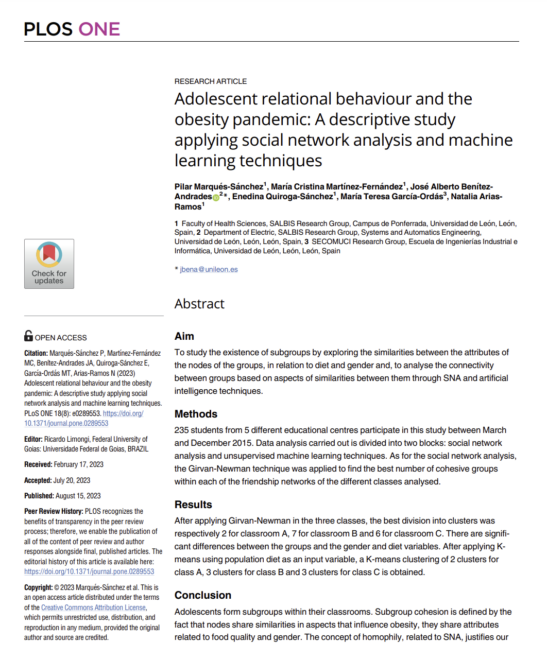- Published: August 15, 2023
- https://doi.org/10.1371/journal.pone.0289553
Abstract
Aim
To study the existence of subgroups by exploring the similarities between the attributes of the nodes of the groups, in relation to diet and gender and, to analyse the connectivity between groups based on aspects of similarities between them through SNA and artificial intelligence techniques.
Methods
235 students from 5 different educational centres participate in this study between March and December 2015. Data analysis carried out is divided into two blocks: social network analysis and unsupervised machine learning techniques. As for the social network analysis, the Girvan-Newman technique was applied to find the best number of cohesive groups within each of the friendship networks of the different classes analysed.
Results
After applying Girvan-Newman in the three classes, the best division into clusters was respectively 2 for classroom A, 7 for classroom B and 6 for classroom C. There are significant differences between the groups and the gender and diet variables. After applying K-means using population diet as an input variable, a K-means clustering of 2 clusters for class A, 3 clusters for class B and 3 clusters for class C is obtained.
Conclusion
Adolescents form subgroups within their classrooms. Subgroup cohesion is defined by the fact that nodes share similarities in aspects that influence obesity, they share attributes related to food quality and gender. The concept of homophily, related to SNA, justifies our results. Artificial intelligence techniques together with the application of the Girvan-Newman provide robustness to the structural analysis of similarities and cohesion between subgroups.
Citation: Marqués-Sánchez P, Martínez-Fernández MC, Benítez-Andrades JA, Quiroga-Sánchez E, García-Ordás MT, Arias-Ramos N (2023) Adolescent relational behaviour and the obesity pandemic: A descriptive study applying social network analysis and machine learning techniques. PLoS ONE 18(8): e0289553. https://doi.org/10.1371/journal.pone.0289553
Editor: Ricardo Limongi, Federal University of Goias: Universidade Federal de Goias, BRAZIL
Received: February 17, 2023; Accepted: July 20, 2023; Published: August 15, 2023
Copyright: © 2023 Marqués-Sánchez et al. This is an open access article distributed under the terms of the Creative Commons Attribution License, which permits unrestricted use, distribution, and reproduction in any medium, provided the original author and source are credited.
Data Availability: All relevant data are within the paper and its Supporting information files.
Funding: The author(s) received no specific funding for this work.
Competing interests: The authors have declared that no competing interests exist

